_
“The Next Frontier in Social Justice”
Lately, social justice warriors have exhibited considerable agitation and sense of urgency over the rights of transgendered people, who are said to suffer considerable discrimination, harassment, and lack of acceptance. Joe Biden declared discrimination against this minority “the civil rights issue of our time,” while journalists and activists speak excitedly of transgender rights as “the next frontier.”
Just enforcing existing, or passing new, anti-discrimination laws is not enough, we are forewarned. “Cultural protections” for transgendered people, commonly known as trans*, will be erected, and society will be re-educated about how it conceives of sexual identity. “[I]t will need to reevaluate just how necessary it really is to define people according to what’s between their legs. This would clearly help the transgender community, but it might be healthy for the rest of us, too.”
The so-called “gender binary”, where the world is viewed as male and female, is evil and wrong, we are instructed. We must all now embrace the “Gender Spectrum” (“GS”), which better reflects nature and most importantly, is “inclusive.”
But is this novel way of perceiving human sexuality valid? What, if any, scientific evidence exists to support it? And why is changing not just how people treat trans*, but how they think and feel about their own sexuality, so important? We shall see.
__
Terms
The Gender Spectrum has been defined as
“… a range of gender identities between and outside of the categories of male and female…”
which is usually expanded to include Gender Expression, “the ways in which people externally communicate their gender identity to others through behavior, clothing, haircut, voice, and other forms of presentation”, and Gender Role, “the set of roles, activities, expectations and behaviors assigned to females and males by society.” Sexual orientation (gay; straight; bi; asexual) is also frequently placed under the rubric.
In contrast to the “static, binary model”, The Gender Spectrum is presented as a “more nuanced, and ultimately truly authentic model of human gender” that describes the “far more rich texture of biology, gender expression, and gender identity intersect in multidimensional array of possibilities.” The concept has been around for about fifteen years.
Gender itself is a fairly recent coinage that refers to the personal sexual identity of an individual above & beyond their biological sex. People almost always identify as the gender that matches their sex, but trans* either identify as the gender opposite their sex, or, in rare cases, have no clearly defined gender identity. The causes of transgenderism are poorly understood. (A small fraction of the population is intersex — people who, due to genetic or embryological anomalies, have genitalia & other physical sexual traits that are neither completely male or female. Intersex is separate from transgendered.)
__
Numbers
When people discuss transgenderism and the GS, they can be maddeningly vague with quantification — ‘not all people conform…’ or ‘many people express…’ or ‘some people display…’ etc. There happens to be a debate raging over the figures generally cited for prevelance of transgenderism. The American Psychiatric Association (APA) gives 1:30,000 among men and 1:100,000 among women, figures that found their way into APA’s DSM V. But these derive from just a handful of forty year-old studies, and Lynn Conway, a mathematician and a trans* zirself, has made a compelling argument that they’re off by several factors.
By adding up sex reassignment surgeries (SRS) performed in the US since the 1960’s, Conway arrives at a minimal transgender prevalence of 1:2,500, or 0.04%. But considering lessening stigma, and that not every person who identifies as trans gets SRS, more trans* are likely out there. Through a series of assumptions & back-of-the-envelope calculations, Conway extrapolates to a final estimate of 1:170, or <0.6%
A careful & comprehensive meta-study by UCLA’s Williams Institute, conducted in 2011, found that ~ 0.3% of US residents identified as trans* — all things considered, within the same ballpark as Conway’s figure. The results of other recent surveys tend to fall within Conway’s base and peak estimates.
Whether trans people constitute 3/10ths or 6/10ths of a percent of the population, describing them as ‘some’ is vague, and as ‘many’ downright misleading. ‘Very few’, ‘a small fraction’ and ‘rare’ are more fitting, as this visualization of the UCLA estimates makes clear:
Now, this is not to say that, just because trans* are a tiny minority, they are not deserving of our respect or equal rights. As Conway observes, the prevalence of blindness and deafness are similarly low, but society takes great pains to accommodate the blind and the deaf.
__
The Nature of Sex
This may seem pedantic, but a basic review of sexual development & reproduction is in order before examining the validity of the GS.
Homo sapiens reproduce sexually, as have our ancestors for the past 1.2 billion years. By design, each human comes equipped with either exclusively female, or exclusively male sex organs. We are not hermaphroditic, are incapable of parthenogenesis, nor do we self-pollinate.
Sex is determined by the X and Y chromosomes. Get two Xs and you’re female; an X and a Y, and you’re male — it’s either/or. (Specifically, the SRY gene on the Y chromosome determines maleness.) Rarely, something goes wrong when the gametes merge, creating a zygote with a lone X, an XXY, XXYY, or an SRY gene that’s fallen off the Y chromosome or migrated to an X. A meiotic anomaly can create XYY. Individuals born with any of these karyotypes are known as intersex and (except XYY) are infertile.
In the womb, the precisely-timed delivery of precise amounts of hormones is required for the initially amorphous embryo to develop either male or female attributes. This process, too, infrequently goes awry, leading to individuals with genitalia and other physical sex attributes that are neither fully male nor female. They are also intersex and infertile.
It must be stressed that karyotypic and embryological anomalies are errors in the processes — fatal breakdowns, actually, from the perspective of the germ line — and in no way ‘natural’ variants of sex. (It’s noteworthy that intersex pregnancies spontaneously abort at a far higher frequency than average.) This should be an uncontroversial statement of fact, yet there are those who deny it.
The group GenderSpectrum.org insists
“… even if gender is to be restricted to basic biology, a binary concept still fails to capture the rich variation observed. Rather than just two distinct boxes, biological gender occurs across a continuum of possibilities. This spectrum of anatomical variations by itself should be enough to disregard the simplistic notion of only two genders.”
Evidence of this “biological continuum” presumably includes:
- 5-Alpha-Reductase Deficiency — incidence of births 1:40,000
- Androgen Insensitivity Syndrome (XY female) — 1:20,000
- Cloacal Exstrophy — 1:400,000
- Congenital Adrenal Hyperplasia (CAH) — 1:14,200
- Klinefelter Syndrome (XXY males) — 1:1,000
- Mullerian Agenesis (congenital absence of a vagina) — 1:5,000
- Partial Androgen Insensitivity Syndrome (PAIS) — rare, incidence unknown
- Swyer Syndrome (XY gonadal dysgenesis) — 1:30,000
- Turner Syndrome (45,X0) — 1:2,500
This is idiotic. The above are all intersex conditions where the natural sex determinant processes have gone awry. Intersex people deserve our compassion and our support in developing their personal gender identity. Their conditions, however, are birth defects, not “rich variations.”
__
The Nature of Gender
To successfuly reproduce, an individual must: 1) attract members of the opposite sex; 2) be attracted to members of the opposite sex. Mating relies on physical cues and behaviors to achieve these two objectives. These physical traits and behaviors are fixed, phenotypic expressions of the genome.
For humans at least, it’s generally assumed that a gender identity is generated within the mind. To the best of my knowledge, humans are also the only animals who’ve developed elaborate cultural rituals and cues (most notably, hoop earrings, raised pick-up trucks, & line dancing) to augment or supplant instinctual sex behaviors and attributes.
Getting one’s gender identity or sexual attraction wrong is, again from the perspective of the germ line, a fatal mistake. That’s why we don’t find any trans* animals or gay animals. (Homosexual behaviors have been observed in animals, but they are — aside from one known example of male beetles depositing sperm packets on other males’ carapaces, and that an alternate, “piggy-back” strategy for delivering sperm to females — for dominance or other non-sexual social purposes.)
Homosexuals, bisexuals, and trans* are, of course, found among humans. Some hypothetical explanations for a genetic basis to homosexuality have been put forth (based on outlaw genes, kin selection), but no hard evidence exists (i.e., no “gay gene” has been found.) Pre-natal hormonal imbalances have been tentatively linked to lesbianism. Instances like ancient Sparta imply that culture can influence human sexual attraction. And that’s about the extent of what we know at this point.
How gender identity forms is even less clearly understood. A few studies have found that the brains of MtF trans* resemble the brains of normative females in certain ways, but no causation arrow can be attached to this correlation. What can be said is, although gender self-identification can sometimes be mutable in childhood, it nearly always is fixed by puberty.
In all but a tiny fraction of instances, gender identity aligns with anatomical sex. This should be considered the normative, default position. (Please bear in mind that this is not by any means a moral judgment.) Further, in most trans*, it seems that this default position has simply been reversed. Whether that cortex where gender forms developed differently in the womb, or whether the social cues that influence gender went askew, most trans* identify with the sex directly opposite their anatomy. A mere fraction of the fraction of people who are trans* are ambivalent, or “gender fluid”.
As with pretty much everything about us, nature and nurture are likely at play. Research into the mechanics of gender identity is almost non-existent, but the patterns indicate that we are predisposed toward a default ‘cis’ identity, with embryological or environmental anomalies sometimes perturbing it.
__
What Spectrum?
Scientific inquiry may thrive on tentative claims that are only as assertive as the evidence merits, but crusades are waged on dogmatic certainty. The social justice crusade to transform society’s attitudes about sex and expression requires that a continuous spectrum of gender identity exist across the entire population. The graphics found in SJW literature give an idea of how they envision the Gender Spectrum:
(Answer three simple questions about your wardrobe to learn where you fall on the Spectrum!)
—
(Reminder: Intersex is not the same as transgender.)
—
(As you become more masculine, you eventually turn feminine?)
—
(Why don’t these people have necks?)
—
Let’s compare those to a graphic representation of the findings in the UCLA study:
Do you see a spectrum, or a binary?
Ah, but, the SJW replies, you’ve ignored the hidden influence of sexual attraction, gender expression and gender role-playing. So let’s address those, too.
_
Sexual Attraction
Whether you’re hetero-, homo-, or bi-sexual seems to me a separate issue from your gender identity, and even granting that connection, the raw data does not reveal a spectrum. The UCLA study estimated 3.5% of US adults identified as lesbian, gay or bisexual.
Other studies conducted over the past decade in the US, Canada, Western Europe and Australia, ranged from 1.2% to 3.7%, with one outlier at 5.6%.
Ah, but, comes the retort, as the noted anthropologist, Honey Boo-Boo, observes: “everybody is a little bit gay.” Straight, gay, bi — these are just artificial cubby holes! In fact, in all the surveys UCLA looked at, more people reported having had same-sex attractions than self-identify as gay or bisexual. Taking the highest figure, 11.0% (from that outlier study, the 2006-2008 National Survey of Family Growth,) let’s graph it out:
The 89% of adults who reported having never had a same-sex attraction appear on the far left. For the purpose of this exercise, and lacking precise data, I’ve evenly spread out the other 11% along the ‘gayness’ scale, despite indications that around half of gay people are also decidedly ‘binary’ in their attractions. For the overwhelming majority of people, there is no spectrum.
—
Gender Expression, Gender Roles
When it suits them, SJWs insist that gender identity is hard-wired, and we so often hear them speak of ‘a girl born in the body of a boy.’ But when it’s time for the Cultural Revolution to begin, gender suddenly becomes mutable:
“Gender expectations and messages bombard us constantly…. Like other social constructs, gender is closely monitored by society. Accepted social gender roles and expectations are so entrenched in our culture that most people cannot imagine any other way.”
Thus, not only does society have no room for trans* expression, it actively suppresses the hidden gender-fluid tendencies inside all of us. This argument, however, is predicated on the alleged disparity between the ‘artificial’ binary and the ‘natural’ spectrum. As shown above, both gender identity and sexual attraction display marked binary properties. Spectrum advocates complain that
“individuals fitting neatly into [social gender role] expectations rarely if ever question what gender really means. They have never had to, because the system has worked for them.”
Could it be that the vast majority of people prefer these standard roles? Not the slightest effort has been made to produce concrete evidence showing otherwise — or to explain, exactly, why safeguarding the rights of a minority requires the majority to alter their private behavior and deepest self-perceptions. So, when Pistol Annies affirm that there’s nothing better than being loved by a workin’ man, who won’t do the dishes or laundry, but who can fix about anything and will keep your car real clean, instead of trying to re-educate those gals, we should take them at their word.
That being said, if, as a society moving toward greater egalitarianism and less gender-based dichotomy of labor, we now choose to relax enforcement of traditional gender roles for those who choose to deviate from them, that’s a good thing. But no half-baked theory is required to explain David Beckham or Steven Tyler. And we can have women astronauts and men nurses, women in suits and men in scarfs, women who chop wood and men who cry during TERMS OF ENDEARMENT, without the need to pretend they aren’t fully women and fully men.
__
Culture Club
Spectrum advocates assert that “[g]ender diversity is a normal part of human expression documented across cultures and recorded history,” and point to
“[n]on-binary gender diversity … throughout the world, documented by countless historians and anthropologists. Examples of individuals living comfortably outside of typical male/female identities are found in every region of the globe. The calabai, and calalai of Indonesia, two-spirit Native Americans, and the hijra of India all represent more complex understandings of gender than the simplistic model seen in the west.”
It is indeed possible to find scattered examples of cultures tolerant of intersex and transgendered people. (Sadly, they seem the exceptions to the rule.) One might well cite these examples to encourage greater tolerance in our own society. But they simply do not hold up as evidence of a gender spectrum. Just because these pre-modern societies — ignorant of chromosomes, pre-natal development, or orbital frontal cortices — invented third, fourth or fifth “sexes” to explain certain phenomena, doesn’t mean extra sexes exist for real.
Further, for this to serve as proof that our “simplistic” binary model actively suppresses expressions of gender non-conformity, SJWs would need to produce data showing a significantly higher prevalence of gender-queer individuals in these cultures. They haven’t bothered, and likely can’t.
Finally, hirja of the Indian subcontinent traditionally had, and often still have, their penis and testicles chopped off as boys, then are forced into a life of prostitution. This is not a cultural practice we should seek to emulate.
Spectrum proponents say our gender roles are ‘just a social construct.’ But societies and cultures do not appear out of thin air. The origin of human societal culture can be traced back through the group behaviors of our hominid & earlier social animal ancestors, all the way to the mating instincts of the first sexually-reproducing creatures. Our cultural gender constructs are the direct product of, and are designed to facilitate, sexual reproduction. Far from being arbitrary or capricious, our ‘binary’ gender roles and expressions precisely replicate the function of fixed sex displays like plumage or instinctual behaviors. Baby, It’s Cold Outside is a mating dance.
__
The Insane Charade
We have shown that:
- Trans* individuals are extremely rare (~ 0.3%);
- Same-sex attraction is rare (~ 3%);
- Our species is by design a sexual binary of male and female;
- The vast majority of people — cis and trans*, straight and gay — self-identify as either male or female;
- Normative cultural gender roles and expressions, albeit sometimes taken to extremes by certain cultures, are consistent with that sexual binary and naturally emanate from it;
- A large majority of people are comfortable with standard gender roles and forms of expression. That almost no one conforms to clichéd, exaggerated stereotypes is unremarkable; that a few people deviate widely from standard gender expressions does not equate to a smooth variance across the entire population, much less is proof of the existence of extra sexes.
In spite of all this evidence and logic, SJWs damn anyone who doubts the Gender Spectrum as ignorant and hateful.
Not atypically for SJWs, they conflate two separate arguments. The first, that trans* deserve equal treatment under the law, and don’t deserve ridicule or abuse, is one I heartily agree with, as would any fair-minded person.
Their other argument, over which they have launched a crusade, and against which they are experiencing considerable push-back, is that society must be restructured, our public institutions revamped, our very perceptions altered, to conform to a non-existent gender spectrum. So people are shamed for finding trans* sexually unattractive, or for denying that they themselves secretly harbor homosexual feelings. “He” and “she”, “his” and “hers” are banned as Words of Intolerance™, and we are now expected ask each person what are zir preferred pronouns before addressing qi. Teachers and students receive indoctrination sensitivity training to embrace the legions of spectrum-queer in their midst.
We have SJWs demanding that trans* be allowed to express their gender in any way they see fit, and expect ‘cis folk’ to not just tolerate it, but to find it groovy. Then, without batting an eye, they hector and shame people who desire and enjoy traditional gender roles and expressions.
We have parents now raising their children as gender neutral, afraid to impose arbitrary idenities in case their kid might be ‘two-spirit.’ Worst of all, many SJWs and therapists now actively encourage children as young as 3 years of age to identify as trans*. Considering that, while some amount of gender nonconformity & ambivalence is relatively common among children, nearly all children who experience it sort things out on their own to become ‘cis’ by puberty, this is unconscionable.
All this is stupid and wrong, highly unfair to individuals and disruptive to society. I don’t care how often you berate me, how many times you label me a ‘hater’, a ‘trans-phobe’, or ‘cis scum‘, I will not participate in your insane charade. I’ll gladly stand up for equal rights for trans* people, but I won’t deny the facts: there is no Gender Spectrum.
(c) 2013 by Matt Cavanaugh. All rights reserved.
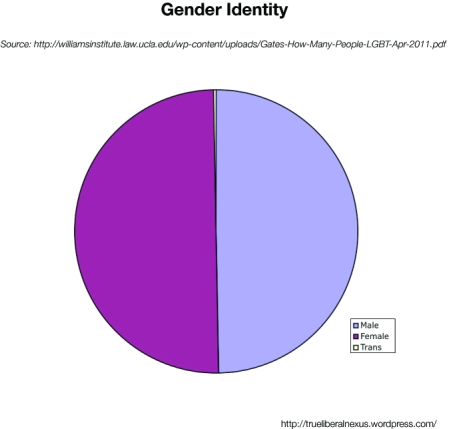
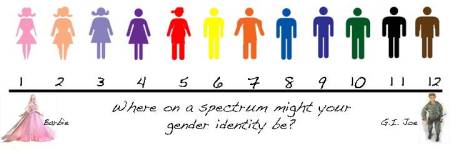
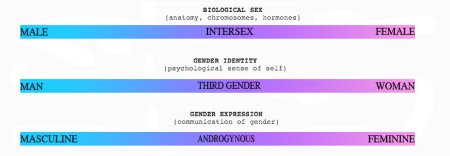
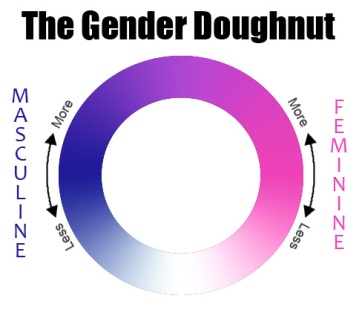
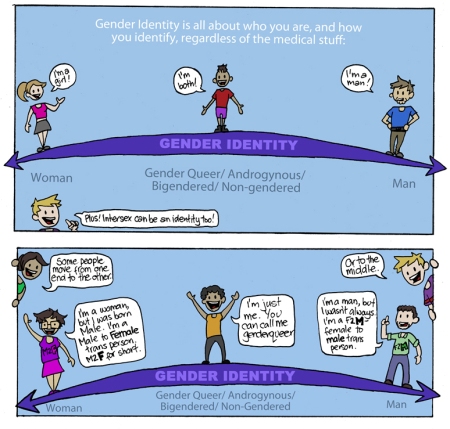
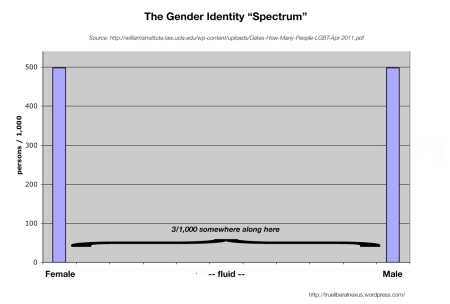
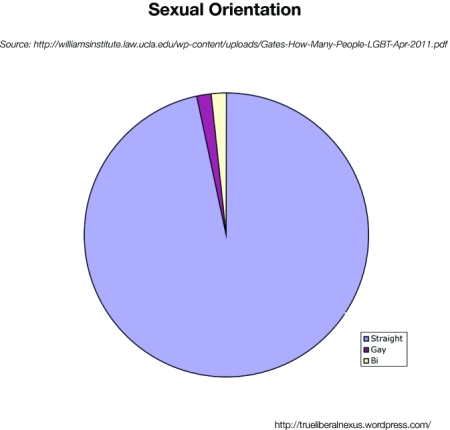
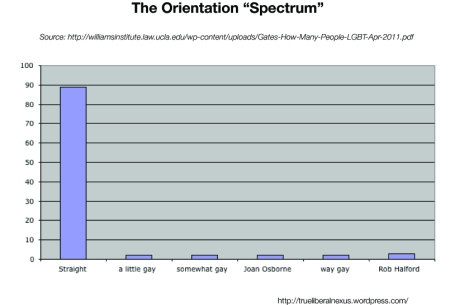
You are being asked to login because Tong.Duurai@gmail.com is used by an account you are not logged into now.
By logging in you’ll post the following comment to What Gender Spectrum?:
Interesting post. But what many liberals fail to grasp is the topology of the gender spectrum. The gender spectrum is NOT an open set. Mapping the gender spectrum onto a doughnut is not a bijection because it is a 2-to-1 mapping so it’s not a homeomorphism. The gender spectrum is a CLOSED set with 2 distinct endpoints. So both of those endpoints have neighborhoods surround them(disks in the plane) that do not intersect.
In the case of transgenderism, the scientific evidence suggests that this condition is epigenetic. Trans-women have brain structures that are isomorphic to those found in the majority of women and trans-men have brain structures that are isomorphic to men. Hormone levels in utero are what determine the sexual identity of the brain. And when these hormone levels are abnormal, the sex of the brain is inconsistent with the sex of the body.
And finally, WRT intersex people, humans aren’t sea slugs. That is, true hermaphroditis is entirely absent in human biology. So humans cannot be both biologically male and female. Which explains why the gender spectrum cannot be mapped to a doughnut.
Thanks for this post. I’ve been trying to figure out what on earth the gender spectrum is for quite sometime but can’t ask the people who talk about it because their responses are usually along the lines of, “It’s not my job to explain, google it you privileged cis”. This breaks it down and allows me to understand while also verbalizing some of my frustrations with these people. Thanks again.
This is a very reasonable and considerately written piece. I am transgender (female in male body) and agree with your statement that it is not normal but that they should be supported. Most of what you put forward was logical and truthful.
The problem I have is your representation of the gender spectrum (or lack thereof). It seems the way the question is asked will determine the answer. If you ask people to choose a category then people will be grouped in categories. If you’re asked to place yourself on a scale then people will do so and then you will indeed have a scale. The fact that the ends of the scale are far more common doesn’t mean the scale doesn’t exist.
Think of a tomboy (I know, I know I’m using a stupid stereotype but it’s to communicate an example). She might identify simply as female but then put herself towards the middle of the scale. The scale is therefore a more accurate representation rather the putting her in a category, which is overly simplistic, albeit accurate for ~90% of people. Maybe categories suits gender identity and a scale is more appropriate for gender expression.
I agree that forcing ideas on people and being too quick to be argumentative is not helpful at all. The point is to let people be who they are and to break down stereotypes so that people feel comfortable being anywhere on the gender expression scale.
I think this is the reason to have parenting that is closer to gender-neutral. That way kids are not told they must be a certain way and like certain things and therefore aren’t forced to conform to a stereotype. I am not doubting the natural emergence of binary gender. The fact that it is natural means it doesn’t have to be enforced in any way.
Laura, thank you for your thoughtful comment on a very old post!
I agree that, while gender identity is strongly binary, there’s considerably more range displayed in what’s commonly termed gender “expression.” (e.g., your ‘tomboy’ example.) I favor our culture granting such leeway and oppose forced or pressured stereotypes. My observation has been, though, that even when given such freedom, people tend to willingly & eagerly choose typical gender expressions.
Sadly, considerable pressure & shaming comes from the ‘social justice’ Left directed at anyone who is content with a typical identity or expression.
My other complaint is, by falsely conflating sexual attraction (a.k.a. “orientation”), gender ID, & gender expression, a disservice is done to understanding and supporting three distinct, albeit often overlapping, phenomena.
I have reservations about gender-neutral parenting. I agree that children should not have stereotypes forced upon them. It does seem that children naturally seek to identify and adopt gender expressions linked to their sex (or, for trans people, their gender ID). It would therefore be just as wrong to forcibly neutralize all behavior in children. I strongly oppose raising children as a neuter gender. Given that: c. 75% of children never question their gender ID; that of the remaining 25%, most sort it out on their own with gender ID matching sex; while the majority of children who end up trans* seem very sure of their ID, raising all children as neuters provides no value-add while only confusing a great number of otherwise centered children. Caveat: children & youth experiencing uncertainty about their ID should be permitted to ‘try out’ a gender and to freely ‘switch back’, without shaming or coercion in either direction. This, as conscientious professionals like WPATH recommend, and responsible parents like Jazz Jennings’, practice.
Amazing blog post. I’m very disturbed how little is written contesting the dogma of the “gender spectrum” by gender activists and SJWs (which stems from postmodernistic beliefs in some ends of the social sciences). What is even more horrifying is that these ideas are indeed being taught to kids in some places (e.g., Ontario, Canada recently revised their sex ed curriculum and includes all this gender identity politics nonsense in there) yet there is no science to back it yet all the constant false information presented about this by the media (e.g., Science proves gender fluidity). As an educator it greatly disturbs me and I appreciate your blog entry here.
Thanks again!
bend me over
It must be stressed that karyotypic and embryological anomalies are errors in the processes — fatal breakdowns, actually, from the perspective of the germ line — and in no way ‘natural’ variants of sex.
What does “natural” mean here? I have never heard any modern biologists talk about some biological variations in a population as “natural” and others not. That sounds more like an older Aristotelian way of thinking about biology where each species has a “form” that defines how it is “supposed to” look and function, but there can be “accidental” deviations from the ideal, like an animal missing a leg. But of course this kind of thinking doesn’t seem very compatible with Darwinian evolution, where variations that deviate from what an Aristotelian would think of as the essential features of one species can spread and eventually cause the population to evolve into an entirely different species where the new traits would be typical for that species.
I would understand if you were just using “normal” to distinguish traits that are statistically seen in most individuals from those that are statistically anomalous, but that can equally apply to traits we might see as beneficial as ones we would see as harmful (whether in terms of societal judgments or in terms of biological fitness, the latter being perhaps suggested by your comment about intersex conditions as ‘fatal breakdowns, actually, from the perspective of the germ line’, though note that some people with intersex conditions can still have children and thus pass on their germ line cells). In addition, some traits which are statistically unlikely to be found in a randomly chosen individual are nevertheless highly probable to occur in some small fraction of a larger population, for example all large populations of humans (or other mammals) around the world have some small fraction whose primary sexual characteristics are sufficiently anomalous that we would define them as “intersex”.
Do you think all significant biological variations from the mean are “unnatural”, for example being gay or being unusually intelligent (assuming there’s a strong genetic component to both?) If not, what criteria would you use to distinguish natural variations from unnatural ones, other than just something like quality of life or ability to function in society? (which are the only real reasons something like schizophrenia is considered a ‘disorder’ while high intelligence is not, there are no strict scientific criteria for deciding which mental deviations from the mean are disorders and which are not)
I was merely alluding to the phraseology of radical trans activists, who wrongly believe each intersex condition to be one of nature’s many sexes.
The only phenomena I’d classify as ‘unnatural’ would be man-made ones.
Glad to see you’re back, or I am–WP is blocking my likes, but somehow I’m back in TLN land. I tried years ago to calculate the ratio (before the big shift in self-identification) and I estimated 1: 20,000 for the trans community. But it must be far higher now?